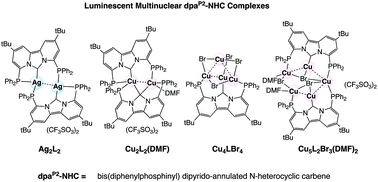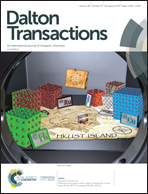Bis(diphenylphosphinyl)-functionalized dipyrido-annulated NHC towards copper(i) and silver(i)†
Abstract
The coordination chemistry of our recently isolated bis(diphenylphosphinyl)-functionalized dipyrido-annulated NHC (N-heterocyclic carbene), dpaP2-NHC, towards copper(I) and silver(I) has been studied. Based on dpaP2-NHC, two dinuclear silver and copper complexes [2, (Ag2L2) and 3, (Cu2L2)], two tetranuclear copper complexes {4, [Cu4L2(NCMe)2] and 6, (Cu4LBr4)} and a pentanuclear copper complex [5, (Cu5L2Br3)] exhibiting strong intramolecular metal–metal interactions were achieved and characterized. All the complexes exhibited dynamic behavior in solution, in which the NMR coalescence of 2 was well resolved at low temperature (below 208 K) and dissociation for 2 was observed according to the calculated Eyring plot. Ag2L2 (2) shows a similar coordination sphere to that of our previously reported gold complex Au2L2; Cu2L2 (3) features a rare μ2-bridging carbene and a terminal carbene; Cu4LBr4 (6) is neutral and monomeric, in which four copper atoms were rigidly fixed by the tridentate dpaP2-NHC ligand and bromide anions. All the complexes (2–6) were luminescent at room temperature, in which 4–6 provided phosphorescence at 77 K. Based on the comparison of the emission bands with dpaP2-NHC, we conclude that the electronic transitions of 2–6 can be attributed to the ligand-centered (LC) transitions.



 Please wait while we load your content...
Please wait while we load your content...